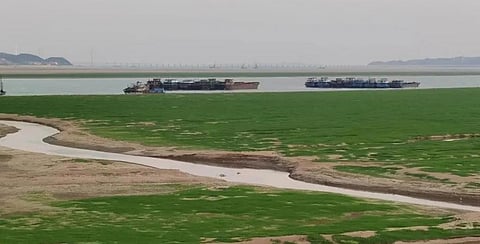

The intensity, impact, scale and duration of the heatwave in China this summer have broken all records. A nationwide drought alert was issued August 19, 2022 as the long-running heatwave in the country’s southwest region was forecast to continue well into September.
A red alert, the highest in China’s four-tier weather warning system for extreme heat, was issued for the 10th consecutive day August 21, 2022, said Chinese news agency People’s Daily. The country is also taking steps to alleviate the impact of the extreme weather on the autumn harvest.
The record-breaking heatwave has caused its rivers, including the Yangtze, to dry up. The current heatwave has lasted 64 days as of August 15, 2022, with temperatures at 200 monitoring stations above 40° Celsius since August 1, 2022. The Yangtze is the longest river in Asia.
Meanwhile, China’s State Flood Control and Drought Relief Headquarters launched a level-IV emergency response for flood control last week as heavy rains were forecast to lash northern regions of the country, the Chinese news agency reported.
Parts of the country have been battling heat waves since June 13, according to China Meteorological Administration (CMA). The body is the national weather service for China and is based in Beijing.
Poyang Lake, the largest freshwater lake in China, has entered the dry season ahead of schedule due to hot weather. The country last saw a heatwave of 62 days in 2013.
The drought is testing China’s power generation capacity. Hydropower generation in southwest Sichuan Province is heavily affected as the water from major rivers is 20 to 50 per cent less.
The daily hydropower generation capacity of Sichuan dropped by 51.1 per cent to 440 million kilowatt-hours from a previous 900 million as of August 21, 2022.
As many as 66 rivers across 34 counties in southwestern China have dried up due to the scorching heat, reported Indian English daily Hindustan Times. Apart from this, rainfall in southern China is down 60 per cent this year compared to seasonal norms.
High temperatures in July alone caused direct economic losses of 2.73 billion yuan ($400 million) and affected 5.5 million people, the HT report stated.
The drought in most areas of the Yangtze River basin is expected to worsen for at least the next 10 days due to continuous high temperatures and lack of rainfall.
The drought in the upper reaches of the Yangtze River will be eased with as precipitation improves, but the precipitation in the middle and lower reaches of the river will still be low, making meteorological drought in those areas continue to develop reported People’s Daily.
The Three Gorges Dam, the world’s largest hydropower project, has increased its water discharge to help ease the drought in the Yangtze. Artificial rain in the Hubei province will also be undertaken, the media outlet reported.
Economists in the country are also concerned about the impact of a lasting drought on the autumn harvest, which accounts for 75 per cent of China’s total grain output and is only about 50 days away.
An underwater building in the Yangtze River in Ezhou, Hubei Province, has fully reappeared due to the drought. The 700-year-old architectural wonder is usually submerged at least partially in the river.
A total of 914 national meteorological observatories, or 37.7 per cent of the total observatories in China, show temperatures have reached the standard for extreme heat wave events, according to the CMA. Over 260 observatories show historical maximum temperature records have been equalled or exceeded.
Meteorological observation records began in 1961 in the country.